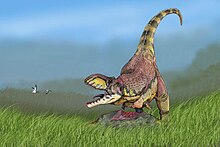Rajasaurus narmadensis
|
Rajasaurus Temporal range: Late Cretaceous, 69 Ma |
|
|---|---|
 |
|
| Restoration of Rajasaurus with prey | |
| Scientific classification | |
| Kingdom: | Animalia |
| Phylum: | Chordata |
| Clade: | Dinosauria |
| Order: | Saurischia |
| Suborder: | Theropoda |
| Family: | †Abelisauridae |
| Genus: |
†Rajasaurus Wilson et al., 2003 |
| Species: | †R. narmadensis |
| Binomial name | |
|
Rajasaurus narmadensis Wilson et al., 2003 |
|
Rajasaurus ('Raja' meaning "king" (derived from Sanskrit) here,"king of lizards") is a genus of carnivorous abelisaurian theropod dinosaur with an unusual head crest. Between 1982 and 1984, its fossilized bones were discovered by Suresh Srivastava of the Geological Survey of India (GSI). Excavated from the Narmada River valley in Rahioli in the Mahisagar district of Gujarat, India, the find was announced as a new genus of dinosaur by American and Indian scientists on August 13, 2003.
Paleontologists Paul Sereno of the University of Chicago, Jeff Wilson of the University of Michigan, and Srivastava worked together as an Indo–American group to study the Narmada River fossils. The fossils represented the partial skeleton of the new species Rajasaurus narmadensis, which means "princely lizard from the Narmada Valley." The fossilized bones of Rajasaurus have also been found in the upriver region of the Narmada, at Jabalpur, in the state of Madhya Pradesh.
Rajasaurus was an abelisaurid, a member of a group of theropod predators known to have lived only on landmasses that were part of the supercontinent Gondwana, such as Africa, India, Madagascar, and South America. Rajasaurus closely resembles Majungasaurus, a contemporary abelisaur from Madagascar, an island that had separated from the Indian landmass about 20 million years earlier. It was found to be an abelisaurid through a phylogenetic analysis of anatomical characteristics, and was described as a carnotaurine abelisaurid (the subfamily including Carnotaurus) because of the configuration of its nasal bones and its possession of a growth ("excrescence") on its frontal bone. Rajasaurus is distinguished from other genera by its single nasal-frontal horn, the elongated proportions of its supratemporal fenestrae (holes in the upper rear of the skull), and the form of the ilia (principle bones of the hip) which feature a transverse ridge separating the brevis shelf from the hip joint.
...
Wikipedia
